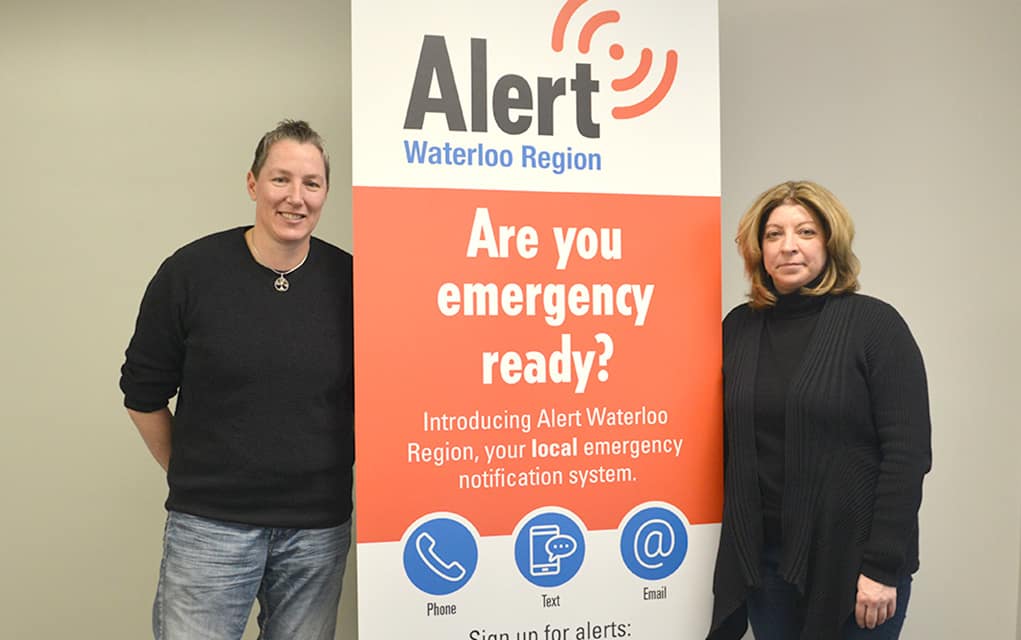If you’re a Woolwich resident who receives an alert message on your cell phone in the next few weeks, it’s because the township is the first municipality to try out the region’s new emergency notification system.
Staff at the township are encouraging residents to sign up online for the new Alert Waterloo Region program to receive public safety messages as quickly as possible. Alerts would be sent out in the event of a power outage, severe weather warning, or a fire/explosion.
“Let’s say we have a flood emergency, we would send a template flood warning to let citizens know to take care and be careful at rivers, have your emergency kit ready, and we’ll redirect them to the website as well as the Grand River website,” said Sandy Van Solm, manager of emergency management at the Region of Waterloo.
It is replacing the Community Alert Network previously used in the township, and using Waterloo North Hydro customer data from the previous system to send out notifications.
While cell phone numbers may still be in the system, staff are advising the public to sign up through several channels, such as e-mail, in case of an emergency.
“We’re actually recommending that you sign up for multiple methods; the reasoning behind that is that technology behind the scene can get overwhelmed in an emergency,” said Avril Tanner, emergency management coordinator at the Township of Woolwich. “So, for example, the cell phone towers can get overwhelmed; so you may only be to receive an email or a text message based on what’s happening in the area at the time as well.”
Residents can register up to two separate addresses in Alert Waterloo Region. Signing up by email allows staff to send out additional details about the emergency to help residents understand what exactly the alert means.
Staff maintained that the website is user-friendly.
“It’s really easy to subscribe,” said Van Solm. “There’s just an online form – you fill in whatever information you want, with at least one contact information. Your address will be geo-coded right away. Accept the terms of use, then subscribe.”
After the month-long test period in Woolwich, the system will be implemented region-wide to be used by all municipalities in March, including Wellesley, Cambridge, Kitchener, Waterloo, Wilmot, and North Dumfries. This differs from the previous alert system, which was used individually by each municipality.
This month-long testing period was chosen specifically for Woolwich because residents already had an emergency notification alert system in place, so it is not unusual for residents to receive this kind of notification.
“For many years, Woolwich had its own emergency notification system, but we have championed the need for a region-wide system,” said Woolwich CAO David Brenneman in a release. “We are so proud to be partnering with the region, cities, townships and the Waterloo Regional Police Service on this new region-wide state-of-the-art system.”
Tanner added that it would not affect their current siren and shelter program within the township, and encouraged residents to sign up for multiple notifications, including Environment Canada and provincial alerts.
“This is an enhanced service for our community members really to ensure that they receive that message,” said Tanner. “Our existing community alert network has tied in with the sirens we have in Elmira, St. Jacobs and Breslau. And those programs are not changing. So just because we’re changing our community alert network and that system behind the scenes, we’re still continuing to use the siren and shelter program in conjunction with the alert system.”
The new alert system has been a work-in-progress since approximately 2017. The Region of Waterloo and Waterloo Regional Police investigated several different systems before deciding on one that was rebranded to Alert Waterloo Region.
In addition to the alerts, the website provides information as to what to do in the case of each specific emergency. For example, it gives tips about access to safe drinking water and what to do in the event of a power outage.
Subscriptions can be accessed online, and additional information is also available online.









